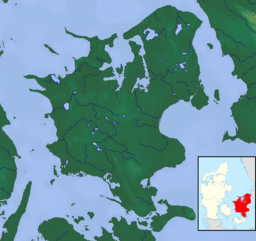| Lake Esrum | |
|---|---|
| Esrum Sø (Danish) | |
 Lake Esrum | |
| Location | Zealand |
| Coordinates | 56°00′14″N 12°22′50″E / 56.00389°N 12.38056°E |
| Type | kettle hole (probably) |
| Primary inflows | Fønstrup Bæk,[1] several smaller streams, groundwater |
| Primary outflows | Esrum Å |
| Catchment area | 62 km2 (24 sq mi) |
| Max. length | 8.4 km (5.2 mi) |
| Surface area | 17.3 km2 (6.7 sq mi) |
| Average depth | 13.5 m (44 ft) |
| Max. depth | 22.3 m (73 ft) |
| Water volume | 233 million cubic metres (189,000 acre⋅ft) |
| Residence time | 12.7 years |
| Surface elevation | Below 9.38 m (30.8 ft) in the summer. Below 9.48 m (31.1 ft) in the winter. |
| Settlements | Fredensborg, Nødebo |
Lake Esrum (Danish: Esrum Sø, pronounced [ˈesʁɔm ˈsøˀ]) is the largest lake in Denmark by water volume and the second-largest lake by surface area, after lake Arresø. It is situated in the central part of North Zealand (the northeastern region of Zealand), straddling the boundaries of the municipalities Hillerød, Fredensborg, Helsingør and Gribskov, some 40 kilometres north of Copenhagen.
The lake covers 17 km2, Its length from north to south is 8.4 km and its maximum depth is 22 m. Its principal drainage is Esrum Å, a 10-km stream which passes Esrum Watermill and the remains of Esrum Abbey on its way to the Kattegat at Dronningmølle. The western shore of the lake is dominated by Gribskov, one of Denmark's largest forests, and the small town of Nødebo. Fredensborg Palace, one of the official residences of the Danish Royal Family, with its extensive gardens, is situated on the southeast shore. Boat trips operate on the lake from Sørup, a village just south of the palace gardens.
- ^ Stenholt Mølle resevatet Archived 2013-12-28 at the Wayback Machine Danish Nature Agency, last paragraph

